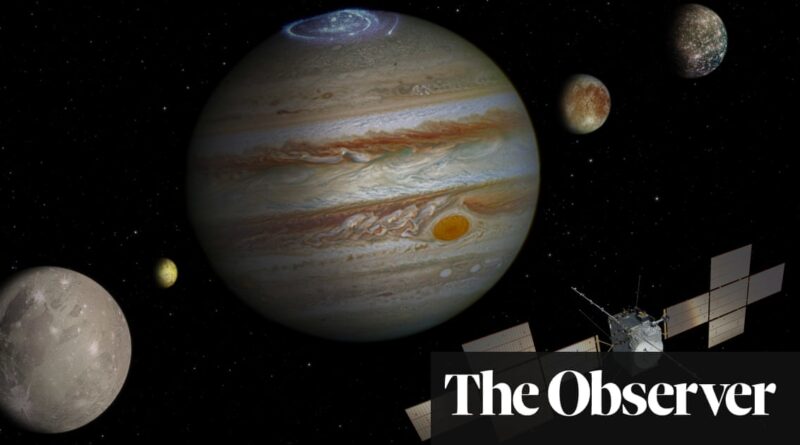‘It will raise hair’: high-risk slingshot will send a robotic mission to Jupiter
European space scientists will this week attempt one of the most powerful interplanetary missions ever. On Wednesday, they will guide their Jupiter Icy Moons Explorer (Juice) to make a flyby of the Earth and its moon and make the first maneuver to assist the two gravitational forces in space.
The light, low-risk exercise is essential to the success of the European Space Agency’s (Esa) mission and its aim is to take the €1.6bn (£1.4bn) robotic spacecraft to its target, Jupiter. in July 2031. begin scanning the giant planet’s two moons, Europa and Ganymede, for signs of life that may lurk in their icy oceans.
However, this process will need to be very precise. The slightest mistake could throw Juice off course and ruin the mission, Esa warned. “It’s like going through a very narrow corridor, very, very fast: pushing the accelerator up when the edge of the road is only millimeters away,” said Juice’s space operations manager, Ignacio Tanco .
This spectacular celestial dance will begin on Wednesday when it passes close to the moon and flies towards Earth, using gravity to change its speed and course as it swings over two worlds. and get involved in the day’s inner workings. . A flyby of Venus will take place next year, followed by two more slingshots past Earth in 2026 and 2029 before Juice finally heads to Jupiter.
It’s a rare “waltz” that will require Juice to move at the right speed, timing and direction for each encounter. However, without such an accurate system, space engineers would not be able to explore the distant planets of the Sun, Esa says.
A direct flight to Jupiter would require Juice to carry 60,000kg of propellant, an impossible load. Furthermore, it would need more fuel to decelerate in order to enter the planet’s orbit. That means that the best way, which uses the inner planets to get the help of gravity to achieve its goal, is the only way to reach the center of the outer planets, say the scientists.
It’s an approach that will be adopted again by Nasa later this year when it launches its Jovian moon mission, the Europa Clipper. Its trajectory will sweep past Mars and return to Earth for a second flight to increase its speed. Although it was launched more than a year after Juice, it will reach Jupiter in 2030 and will focus on Europa while its European counterpart will make Ganymede its main target.
“We know that Europa has an ocean beneath the surface ice and we are certain that Ganymede also has an ocean,” said Professor Emma Bunce, director of the University of Leicester’s Space Center. . “That makes them very interesting targets for our attention.”
Both Juice and Europa Clipper should contribute to the hunt for life in our solar system, and that means a lot depending on how well space engineers at ESA and NASA handle their conditions. flights – starting with Juice’s move this week.
“It’s going to be a lot of fun and a little hair-raising,” added Bunce. “However, this process will be important for the purpose of work. “The more accurate it is, the less fuel we’ll need to use to prepare future studies and the more we’ll have to use to explore Jupiter and its moons.”
Bunce, who was involved in the construction of the two instruments installed on Juice, added that the probe was not designed to directly observe the life of Jupiter’s moons. “It will deal with the question of whether there is life there, by studying the properties of the subsurface oceans. It will tell us whether life can exist or not. well, finding out that life is going to be harder.”
The idea that we could find alien life on ice-covered moons around planets in deep space would have seemed crazy just a few decades ago. The planets closest to the Sun, especially Venus and Mars, were thought to offer the best hope.
But Venus has been found to have a surface temperature of 475C, while its atmosphere has a strong, intolerable pressure that has crushed the robots that get there. In addition, it was discovered that Mars lost its atmosphere and surface water billions of years ago. Efforts to find evidence of subterranean life have so far been fruitless.
On the other hand, researches that were launched a few decades ago revealed that the three largest moons of Jupiter – Ganymede, Callisto and Europa – are ice worlds covered by many oceans of water. water, which is necessary for the existence of life on Earth. US astronomer Neil deGrasse Tyson says: “If there was ever a better place to look for life, it’s right here.”
The problem is that it is very difficult to access. Trips to Mars take about eight months. Juice – which was launched from Esa Kourou airport in French Guiana last year – will take eight years to reach its goal, thanks to all the interplanetary flights it will need – starting this week.
#raise #hair #highrisk #slingshot #send #robotic #mission #Jupiter
